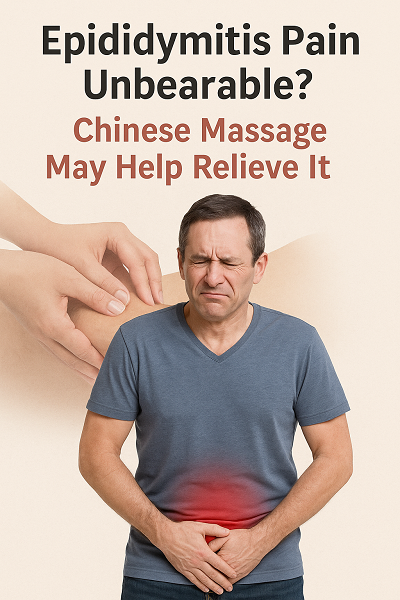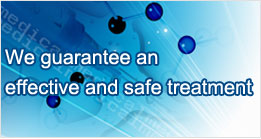Epididymitis Pain Unbearable? Chinese Massage May Help Relieve It!
Epididymitis is a common inflammatory disease of the male reproductive system, characterized mainly by swelling and pain in the epididymis. It predominantly affects young and middle-aged men, with the most common clinical features being pain, discomfort, and swelling in the epididymis, usually unilateral and sometimes accompanied by fever. As the condition progresses, the affected epididymis may enlarge, harden, and develop palpable nodules, worsening the patient's discomfort.

Among male reproductive issues, epididymitis is actually quite common. Many people suffer from symptoms like testicular swelling and pain, which can be so severe that they interfere with daily life and work. When it comes to managing this condition, various approaches have been tried, and Chinese massage has garnered significant attention. But can it really help relieve pain? Below, we'll explore this in detail from the perspective of TCM theory and clinical practice.
Why Can Chinese Massage Help with Epididymitis? What's the Principle?
From the perspective of Traditional Chinese Medicine (TCM), the occurrence of epididymitis is closely related to poor circulation of qi and blood, imbalance of yin and yang, and accumulation of damp heat. When damp-heat pathogens invade the lower jiao (lower abdomen) or emotional distress causes qi and blood stagnation, the meridians around the epididymis become blocked, leading to symptoms like swelling and pain. Chinese massage follows the principle of "free flow prevents pain." By stimulating specific acupoints and meridians, it promotes qi and blood circulation, balances yin and yang, and ultimately reduces swelling and relieves pain.
From a modern medical standpoint, epididymitis is mostly caused by bacterial infections. Local inflammation impairs blood circulation, trapping metabolic waste and worsening pain and swelling. Chinese massage techniques like kneading, pinching, and rolling directly target the scrotum and epididymis, improving local blood flow and accelerating the absorption and metabolism of inflammatory substances, thereby alleviating pain. For example, gently massaging the testicles in circular motions with the palm not only enhances microcirculation but also relaxes tense muscles, significantly reducing discomfort.
The body's meridians form an extensive network, with some, such as the Liver and Kidney meridians, being particularly connected to the reproductive system. Acupoints such as Taichong (LR3, located on the top of the foot between the first and second toe bones), Xingjian (LR2, located on the dorsum of the foot between the first and second toes, proximal to the margin of the web), Sanyinjiao (SP6, located on the medial aspect of the lower leg, posterior to the tibia), Xuehai (SP10, located on the medial thigh), Qihai (CV6, located on the anterior midline of the abdomen), and Guanyuan (CV4, located on the anterior midline of the abdomen) belong to the Liver, Spleen, and Conception Vessel meridians.
Regular stimulation of these points regulates qi and blood, tonifies the liver and kidneys, and activates the body's self-regulating mechanisms to boost immunity. This addresses the root cause of epididymitis, which is the core philosophy of Chinese massage therapy.
How Does TCM Use Massage to Treat Epididymitis?
1. Common Massage Techniques
Kneading Method:
While lying down, the practitioner gently presses the scrotum with their palm, slowly making circular motions over the testicles. The pressure should be moderate—avoid excessive force—to gently stimulate the testicles and epididymis, promoting local qi and blood circulation to reduce swelling and pain.
Pinching Method:
Use the thumb and index finger to lightly grasp the scrotum, gently kneading the testicles with slow, soft motions. Avoid excessive pressure. Occasionally, lifting the scrotum slightly can help relax its muscles and tissues.
Rolling Method:
The practitioner uses the base of the palm to roll and massage around the scrotum and epididymis in small, controlled movements. The area should feel warm but not overheated. This technique broadens the massage's reach, enhancing blood flow in the lower jiao and aiding inflammation relief.
2. Acupressure Points
Massage is more effective when combined with acupressure. The commonly massaged acupoints include:
Taichong (LR3):
Located on the foot, between the 1st and 2nd metatarsal bones, in the depression before their junction. Apply thumb pressure until soreness is felt to soothe liver qi and activate blood circulation.
Sanyinjiao (SP6):
On the inner calf, about three finger-widths above the medial ankle, behind the tibia. Knead clockwise with the thumb to strengthen the spleen, resolve dampness, and regulate qi-blood harmony.
Guanyuan (CV):
On the midline of the lower abdomen, about three finger-widths below the navel. Massage clockwise with the palm to tonify kidney qi and warm the lower jiao, thereby supporting recovery from epididymitis.
3. Enhanced Efficacy with Herbal Medicine
Traditional Chinese medicine for treating epididymitis focuses on overall conditioning. It uses oral Chinese medicine to clear heat and detoxify, promote blood circulation, remove stasis, and relieve pain. Medications like Yin Hua Mi Yan Ling Tablets are commonly used and have good anti-inflammatory and antibacterial effects. Patients with chronic epididymitis can also take safe and side-effect-free Chinese medicine, such as Diuretic Anti-Inflammatory Pill, to eliminate dampness, heat, and stasis in the body and improve the chronic inflammation of the epididymis. Combining Chinese medicine therapy with massage can enhance the absorption of the medicine, leading to faster symptom relief.
In conclusion, TCM massage utilizes specific manipulation techniques and acupoint stimulation to improve local blood circulation effectively, unblock meridians, and alleviate pain and swelling in patients with epididymitis. These therapeutic effects are supported by both TCM's holistic regulatory concepts and modern medicine's microcirculation improvement theory.
However, it's essential to understand that TCM massage is an adjunctive therapy and should not replace primary treatment methods. During acute episodes, prompt standardized anti-inflammatory treatment is essential. For chronic cases, massage should be reasonably applied alongside primary treatments such as herbal medicine regulation. Only by combining various therapeutic approaches can the condition recover more quickly and patients be freed from the distress of epididymitis sooner.



